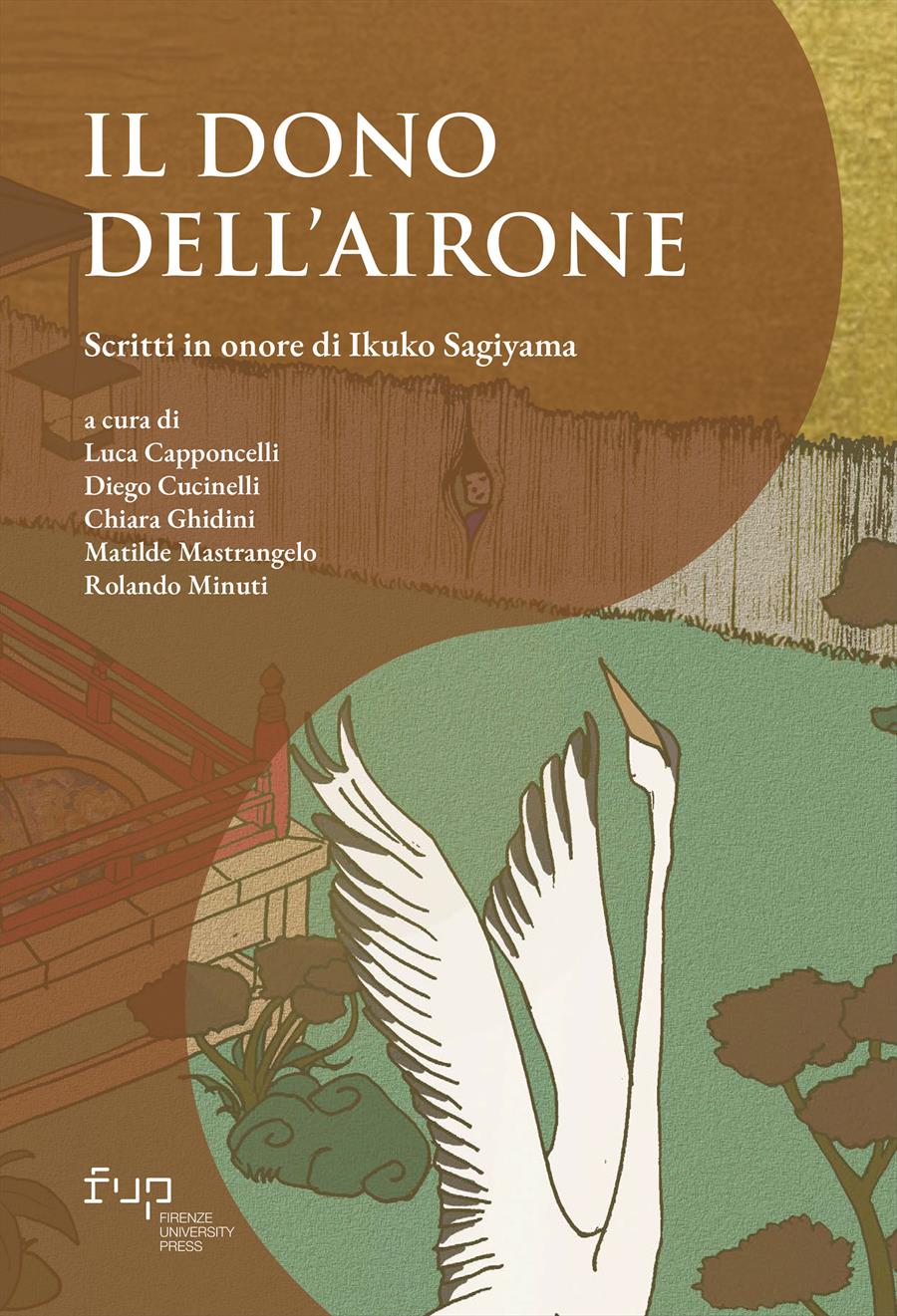- Il dono dell’airone
- Edited by Luca Capponcelli, Diego Cucinelli, Chiara Ghidini, Matilde Mastrangelo, Rolando Minuti
Tracciare il senso di una vita. Wabinureba e Hisakata no nei codici della raccolta poetica di Komachi (Komachishū)
- Francesca Fraccaro
- © 2024 Author(s) |
- CC BY 4.0
- DOI: 10.36253/979-12-215-0422-4.07
The way in which Ono no Komachi’s personal collection (Komachishū) loosely shapes her “life” is believed to have been influenced not only by stories and legends that were orally transmitted soon after her death, but also by the image of flowering and decline depicted in her most celebrated poem, Hana no iro wa. Through an analysis of the textual lines of the collection, this paper aims to shed light on the significance of another renowned poem by Komachi, Wabinureba. This poem is pivotal in establishing one of the central themes of the Komachishū - Komachi’s later life of misery (ukimi) - and serves as inspiration for the chōka that narrates Komachi’s sad and uncertain existence following the loss of her partner. By examining the chōka, this contribution further argues that, as it was included in a previous 45-poem variant text of the Komachishū, it could have served as a potential framework for portraying Komachi's life as depicted in the expanded popular text (the 116-poem rufubon) of the collection.
- Keywords:
- Komachishū,
- rufubon,
- Karakusabon,
- Hisakata no,
- ushi,
University of Florence, Italy - ORCID: 0000-0003-0215-9966
- Akegawa, Tadao. 1982. “Komachi densetsu no kōzō.” Nihon bungaku, 31 (5): 43-53. DOI: 10.20620/nihonbungaku.31.5_43
- Fischer, Felice Renee. 1972. Ono no Komachi. A Ninth Century Poetess of Heian Japan, PhD Dissertation, Columbia University.
- Fraccaro, Francesca. 2010. “Appunti sull’imitazione di Ono no Komachi nel Gosenshū e oltre.” In Un’isola a Levante. Saggi sul Giappone in onore di Adriana Boscaro, a cura di Luisa Bienati e Matilde Mastrangelo, 59-69, Napoli: Scriptaweb.
- Fraccaro, Francesca. 2014. “Lessico affettivo e coscienza sociale nel Genji. Ushi e kokoroushi in Yūgiri e oltre.” Testo a fronte, 51: 95-117.
- Hattori, Yuka. 2016. Heianki ni okeru Ono no Komachi kyōju. Gakui (katei hakase) shinsei ronbun. Nagoya Daigaku. https://nagoya.repo.nii.ac.jp/records/22429
- Itō, Tamami. 2007. Ono no Komachi. Tokyo: Bensei Shuppan.
- Katagiri, Yōichi. a cura di. 1990. Gosen wakashū. Tōkyō: Iwanami shoten. Shin Nihon koten bungaku taikei 6.
- Katagiri, Yōichi.1991. Tensai sakka no kyozō to jitsuzō. Ariwara no Narihira, Ono no Komachi. Tokyo: Shintensha.
- Katagiri, Yōichi. 1993 [seconda edizione]. Ono no Komachi tsuiseki. “Komachishū” ni yoru Komachi setsuwa no kenkyū. Tokyo: Kasama Shoin.
- Katagiri, Yōichi. 2000 [1966]. “‘Ono no Komachi’ kō.” In Kokin wakashū igo, 454-73. Tokyo: Kasama Shoin.
- Katagiri, Yōichi; Tanaka, Noboru. 1999. “Kaidai.” In Reizeike Shiguretei sōsho vol. 20. Heian shikashū 7, a cura di Zaidai hōnin Shiguretei bunko, 1-99, Tokyo: Asahi Shinbunsha.
- Kawashima, Terry. 2001. Writing Margins: The Textual Construction of Gender in Heian and Kamakura Japan, Harvard University Asia Center.
- Kojima Noriyuki. a cura di. 1964. Bunka shūreishū. In Kaifûsô. Bunka shûreishû. Honchô monzui, a cura di Kojima Noriyuki, 185-317; 512-17, Tokyo: Iwanami Shoten. Nihon koten bungaku taikei 69.
- Konishi, Jin’ichi. 1986. A History of Japanese Literature. Volume Two. The Early Middle Ages. a cura di Earl Miner. Princeton University Press.
- Maeda, Yoshiko. 1943. Ono no Komachi. Tokyo: Sanseidō.
- Morimoto, Motoko. 1992. “Shikashū to wa nanika.” In Waka bungaku ronshū 4. Ōchō no shikashū no seiritsu to tenkai, a cura di “Waka bungaku ronshū” henshū iinkai, 1-28, Tokyo: Kazama Shobō.
- Muroki, Hideyuki. a cura di. 1998a. Komachishū. In Komachishū / Narihirashū / Henjōshū / Soseishū / Sarumarushū, a cura di Muroki Hiroyuki, Takano Haruyo, Suzuki Hiroko, 1-26, Tokyo, Meiji Shoin. Waka bungaku taikei 18.
- Muroki, Hideyuki. 1998b. “Kaisetsu – Komachishū.” In Komachishū / Narihirashū / Henjōshū / Soseishū / Sarumarushū, a cura di Muroki Hiroyuki, Takano Haruyo, Suzuki Hiroko, 189-213, Tokyo, Meiji Shoin. Waka bungaku taikei 18.
- Ōtsuka, Hideko 2011. Ono no Komachi. Tokyo: Kasama Shoin. Korekushon nihon kajinsen 003.
- Sagiyama, Ikuko. a cura di. 2000. Kokin Waka shū – Raccolta di poesie giapponesi antiche e moderne, Milano: Ariele.
- Shimada, Ryōji. 1992. “Sanjūrokuninshū no seiritsu.” In Waka bungaku ronshū 4. Ōchō no shikashū no seiritsu to tenkai, a cura di “Waka bungaku ronshū” henshū iinkai, 113-40, Tokyo: Kazama Shobō.
- Sumida, Hiroko. 2009. “Komachishū” no kenkyū, Tokyo: Izumi Shoin
- Takeda, Sanae. 2019 [2003]. “Karakusa sōshokubon Komachishū no ichi.” In Heian chūki waka bungaku kō, 159-87, Tokyo: Musashino Shoin.
- Tanaka, Kimiharu. 1984. Komachi shigure, Tokyo: Kasama Shoin.
- Tochio, Takeshi. a cura di. 1994. Tamatsukuri Komachishi sōsuisho. Ono no Komachi monogatari. Tokyo: Iwanami.
- Yamaguchi, Hiroshi. 1979. Keien no shijin no Komachi, Tokyo: Sanseidō.
- Zaidai hōnin Shiguretei bunko. a cura di. 1999. Reizeike Shiguretei sōsho vol. 20. Heian shikashū 7. Tokyo: Asahi Shinbunsha.
Chapter Information
Chapter Title
Tracciare il senso di una vita. Wabinureba e Hisakata no nei codici della raccolta poetica di Komachi (Komachishū)
Authors
Francesca Fraccaro
Language
Italian
DOI
10.36253/979-12-215-0422-4.07
Peer Reviewed
Publication Year
2024
Copyright Information
© 2024 Author(s)
Content License
Metadata License
Bibliographic Information
Book Title
Il dono dell’airone
Book Subtitle
Scritti in onore di Ikuko Sagiyama
Editors
Luca Capponcelli, Diego Cucinelli, Chiara Ghidini, Matilde Mastrangelo, Rolando Minuti
Peer Reviewed
Number of Pages
390
Publication Year
2024
Copyright Information
© 2024 Author(s)
Content License
Metadata License
Publisher Name
Firenze University Press
DOI
10.36253/979-12-215-0422-4
ISBN Print
979-12-215-0421-7
eISBN (pdf)
979-12-215-0422-4
Series Title
Connessioni. Studies in Transcultural History
Series ISSN
2975-0393
Series E-ISSN
2975-0261
